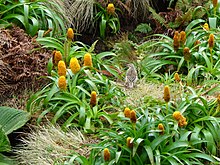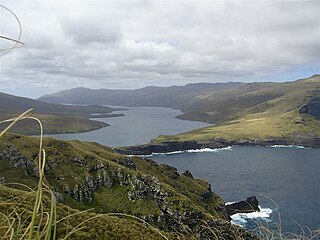
Auckland Island is the main island of the eponymous uninhabited archipelago in the Pacific Ocean. It is part of the New Zealand subantarctic area. It is inscribed in the UNESCO World Heritage list together with the other New Zealand Subantarctic Islands in the region.
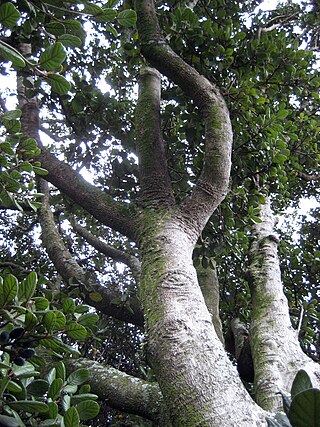
Beilschmiedia tarairi, commonly called taraire, is a tree of the family Lauraceae, endemic to the North Island of New Zealand. It is a common canopy tree in lowland forests north of Auckland, often growing in association with kauri, pōhutukawa, tawāpou, and pūriri on basalt rocks and soils. Beilschmiedia is a genus of about 40 mainly tropical trees and shrubs with alternate to opposite leaves.

Bulbinella is a genus of plants in the family Asphodelaceae, subfamily Asphodeloideae, first described as a genus in 1843. Many species are endemic to Cape Province in western South Africa, confined to the winter rainfall area. Other species are endemic to New Zealand, where they are most common in the central Otago region which enjoys a similar climate to the Cape Region of South Africa.

Nestegis apetala is a small tree native to northern New Zealand and to Norfolk Island. The common names in New Zealand are coastal maire or broad-leaved maire. On Norfolk Island, the common name is ironwood. The species name apetala refers to the lack of petals on the flowers.
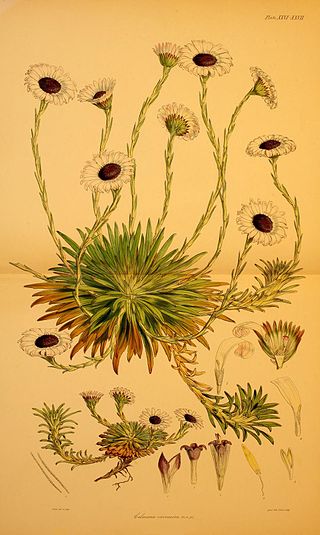
Damnamenia is a genus of flowering plants in the family Asteraceae.

Poa foliosa is a species of tussock grass commonly known as muttonbird poa. It is native to the subantarctic islands of New Zealand and Australia.

Luzula crinita is a species of flowering plant in the rush family that is native to the subantarctic islands of New Zealand and Australia. The specific epithet comes from the Latin crinitus, with reference to the leaves.

Juncus scheuchzerioides is a species of rush variously called short rush or greater rush. It has an Antarctic circumpolar distribution and is native to many subantarctic islands in, and on the regions bordering, the Southern Ocean.

Anisotome latifolia, commonly known as the Campbell Island carrot, is a species of plant in the genus Anisotome of the carrot family (Apiaceae). It is native to the Auckland and Campbell Islands in the subantarctic regions of the South Pacific.

Leptinella plumosa is a small flowering plant in the daisy family. It is a circumantarctic species found on many subantarctic islands in the Southern Ocean. The specific epithet comes from the Latin for “feathery”, referring to the form of the leaves.

Ranunculus pinguis is a dark green, fleshy-leaved buttercup with relatively large, short-stalked flowers and narrow stiff yellow petals that grows in tufts. It is an endemic species of New Zealand on the Auckland and Campbell Islands that flowers from December to January and sets seeds between February and April.

Myosotis antarctica is a species of flowering plant in the family Boraginaceae, native to mainland New Zealand, Campbell Island and southern Chile. Joseph Dalton Hooker described the species in his 19th century work Flora Antarctica. Plants of this species of forget-me-not are perennial with a prostrate habit, bracteate inflorescences, and white or blue corollas. It is one of two native species of Myosotis in the New Zealand subantarctic islands, the other being M. capitata, which also has blue corollas.

Anisotome antipoda is a species of flowering plant in the family Apiaceae, which is endemic to the Auckland, Campbell and Antipodes Islands.

Myosotis capitata is a species of flowering plant in the family Boraginaceae, endemic to the Campbell and Auckland Islands of New Zealand. Joseph Dalton Hooker described the species in his 19th century work Flora Antarctica. Plants of this species of forget-me-not are perennial and erect, and have ebracteate inflorescences and blue corollas. It is one of two native species of Myosotis in the New Zealand subantarctic islands, the other being M. antarctica, which can also have blue corollas.

Marsippospermum gracile, common name - alpine rush, is a flowering plant species in the rush family Juncaceae which is native to New Zealand.
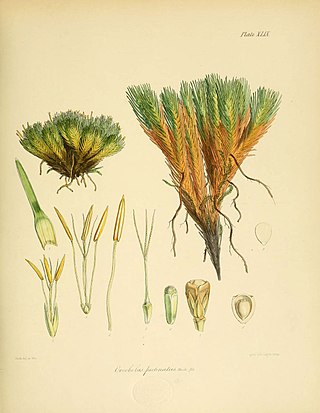
Oreobolus pectinatus is a species of flowering plant in the sedge family that is native to the subantarctic islands, and to the North and South Islands of New Zealand. The specific epithet derives from the Latin, pectin/pectinis,, and refers to the leaves.

Megaherbs are a group of herbaceous wildflowers growing in the New Zealand subantarctic islands and on the other subantarctic islands. They are characterised by their great size, with huge leaves and very large and often unusually coloured flowers, which have evolved as an adaptation to the harsh weather conditions on the islands. They suffer from overgrazing due to introduced mammals.

Myosotis chaffeyorum is a species of flowering plant in the family Boraginaceae, endemic to the South Island of New Zealand. Carlos Lehnebach described the species. Plants of this species of forget-me-not are perennial with a creeping habit, bracteate inflorescences, and white corollas.
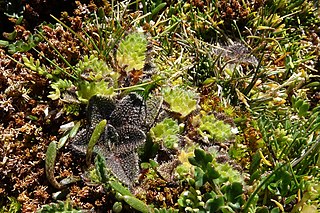
Myosotis antarcticasubsp. antarctica is a subspecies of flowering plant in the family Boraginaceae, native to New Zealand, Campbell Island, and southern Chile. Joseph Dalton Hooker described the species in his 19th century work Flora Antarctica. Plants of this subspecies of forget-me-not are perennial with a prostrate habit, bracteate inflorescences, and white or blue corollas. It is one of two native Myosotis in the New Zealand subantarctic islands, the other being M. capitata, which also has blue corollas.

Myosotis rakiura is a species of flowering plant in the family Boraginaceae, endemic to southern South Island and Stewart Island/Rakiura of New Zealand. Joseph Beattie Armstrong described the species in 1881. Plants of this species of forget-me-not are perennial rosettes which form loose tufts or clumps, with ebracteate, erect inflorescences, and white corollas with exserted stamens.
